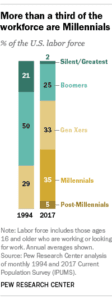In order for a company to stay competitive, they need a fresh approach to compensation that reflects new values, attitudes, and lifestyles. That can include perks such as free lunch, or flexible time off. To help you navigate the best way to attract and retain this millennial generation of talent, CBT Automotive is joined by generation expert and technology speaker, Jeff Butler.
Jeff’s experience working alongside Silicon Valley start-ups and fortune 500 companies has helped thousands of professionals across the United States with hiring and retaining millennial employees. Raised in California, Butler attended and graduated from UC Berkley with a degree in Computer Science. He now travels the country to provide subject matter expertise, entertaining storytelling, and practical, actionable advice on how to optimize today’s multigenerational workforce.
 According to a recent research study, one-in-three business professionals are millennials, making them the largest generation in the U.S. labor force with 56 million. Unlike the generations before them, millennials look at money and time a bit differently. The millennial labor force is growing and is expected to reach 75 million in the future. Naturally, companies and dealerships are trying to figure out the best way to merge the new workforce with the more seasoned employees. According to Butler, this process starts during the hiring stage. He explains how you need to think differently and that starts with hiring strategy. Having videos or a more interactive application or recruitment process will lead to more traffic and interest.
According to a recent research study, one-in-three business professionals are millennials, making them the largest generation in the U.S. labor force with 56 million. Unlike the generations before them, millennials look at money and time a bit differently. The millennial labor force is growing and is expected to reach 75 million in the future. Naturally, companies and dealerships are trying to figure out the best way to merge the new workforce with the more seasoned employees. According to Butler, this process starts during the hiring stage. He explains how you need to think differently and that starts with hiring strategy. Having videos or a more interactive application or recruitment process will lead to more traffic and interest.
Once you hire someone, next is integrating them into the team. This could be difficult as sometimes employees who have accumulated time over the years are not always the most accepting to change. To avoid breaking that paradigm and putting your culture at risk, Butler has a few suggestions to make sure everyone, feels comfortable and the overall goal is clear. First, He says to start with establishing and aligning your team with clear expectations. Next, build your team up to where they are comfortable and driven. Lastly, communication. When you are able to communicate your expectations, goals, and appreciation in a positive, blending way, your team is likely to follow the example.








